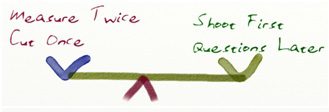‘My pipeline isn’t big enough. We aren’t winning enough new work. We’re not hitting our financial projections. We “lost on price” yet again.’ You might start questioning your business development efforts, proposal writing skills, processes, and/or people for any or all of these reasons. Such concerns lead to a lot of questions, like: ‘Do I have the right people on my team? Do they have the right skills? Are we doing the right things? How can I figure out what we should be doing, and, once I know that, validate that we’re doing it right?’ You can drive yourself crazy with that line of thinking… or you can figure out where you are and where you want to be, then create a roadmap to get from point A to B.
 Having a fix on your current position and a map leading to your growth goals are important factors in the journey to improve your business. If you don’t know where you are going, you will never know when you get there. For instance, suppose you decide that your proposals aren’t as good as they should be. Does that mean you should send your proposal managers and coordinators for training? Or does it mean your capture managers or business developers aren’t doing their jobs right and need development? You have to first identify your weaknesses (i.e. where you are) and your end goal (i.e. where you’re going), and then find and implement solutions to address your problem areas (i.e. your roadmap to success). Simple, right?
Having a fix on your current position and a map leading to your growth goals are important factors in the journey to improve your business. If you don’t know where you are going, you will never know when you get there. For instance, suppose you decide that your proposals aren’t as good as they should be. Does that mean you should send your proposal managers and coordinators for training? Or does it mean your capture managers or business developers aren’t doing their jobs right and need development? You have to first identify your weaknesses (i.e. where you are) and your end goal (i.e. where you’re going), and then find and implement solutions to address your problem areas (i.e. your roadmap to success). Simple, right?
 You and I both know that it is never as easy as it sounds to assess and course correct, and there’s no shortage of people who will gladly take your money in exchange for “helping” you, often through training. The problem is that most businesses offer training with no discernible measurement for what type of training is most needed, for what purpose, to what audience, and in what format. Nothing other than “attendance” is used to measure whether or not the training made any difference to the people who participated in it or if it positively impacted their company’s business development performance. In this arena, it seems that the mantra is more “shoot first, ask questions later” than “measure twice, cut once,” as it should be.
You and I both know that it is never as easy as it sounds to assess and course correct, and there’s no shortage of people who will gladly take your money in exchange for “helping” you, often through training. The problem is that most businesses offer training with no discernible measurement for what type of training is most needed, for what purpose, to what audience, and in what format. Nothing other than “attendance” is used to measure whether or not the training made any difference to the people who participated in it or if it positively impacted their company’s business development performance. In this arena, it seems that the mantra is more “shoot first, ask questions later” than “measure twice, cut once,” as it should be.
There has to be a better answer—and there is. First, determine what gaps you have against a proven business development framework. The OST Business Development Blueprint provides an excellent example that can help you get started. Assess your organization against that framework using our Business Development Assessment Tool to diagnose areas where you can improve. Don’t just rely on your own responses to the assessment, though. No matter how hard you try to avoid it, your answers will be biased. Augment your assessment with an informed review of artifacts from your portfolio.  Since you are focused on Business Development in the Government contracting arena, include a rigorous review of a couple of your best proposals.
Since you are focused on Business Development in the Government contracting arena, include a rigorous review of a couple of your best proposals.
Once you have measured twice, you will know where to cut—or in this case, where to improve your capabilities. These capabilities are embodied in your people, so you do need to provide them with appropriate training, but it should be training that is tailored to your organizational business development needs. Do not send your team to training and assess results the way most do, with subjective learner assessments that ask how they felt about the training and relying on attendance to monitor the impact on your operation. Instead, provide opportunities to engage in and practice the new ideas and behaviors they’ve learned, supported by coaching and reach-back to ensure that the necessary changes have taken root and live on in your organization—not just in the classroom, but during the heat and hustle of winning new work.
Contact us to learn more.

